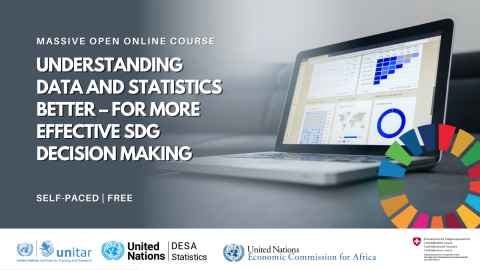
Understanding data and statistics better – for more effective SDG decision making
This course aims to offer a double opportunity: i) to help improve the understanding of how better data can help design more effective public policies and ii) to brush up on your core data skills.
This course[1] aims to offer a double opportunity: i) to help improve the understanding of how better data can help design more effective public policies and ii) to brush up on your core data skills. The course covers aspects related to the interpretation, analysis, and presentation of data of direct relevance to the SDGs and more broadly national and sectoral policies aimed at ensuring sustainable and inclusive development. It introduces these topics using concrete examples of data use and public policy context from around the world. The course reviews both traditional and non-traditional data sources and discusses their uses, as well as the opportunities and challenges presented by the latter. It uses a combination of story-telling, examples, videos and hands-on exercises to tailor to a variety of learners.
[1] Among persons having provided substantive contributions to the development of this course are Sharleen Forbes, John Harraway, Helen MacGillivray, Aniket Bhushan, Vibeke Nielsen, Leandre Ngogang Wandji and Elena Proden.
It is expected that, by the end of the course, participants will be better positioned to:
- Explain the importance of timely, quality and disaggregated data for informing policies and decisions in support of the SDGs;
- Interpret and assess the fitness for purpose of different sources of data depending on the objective and task at hand;
- Effectively and correctly communicate data to tell a story using tables, graphs and maps;
- Identify potential data sources from among official, scientific and new types of data for monitoring SDG indicators using a set of criteria;
- Discuss how data should be used to formulate evidence-based policies or conduct M&E activities.
- Short introductory survey
- Module 1. Statistical literacy
- Module 2. Interpreting and assessing the fitness for purpose of data
- Module 3. Communicating with data
- Module 4. Data sources for SDG indicators
- Module 5. Policy formulation, monitoring and evaluation
- Final assessment
- Feedback survey
This self-paced course consists of five modules developed around specific learning objectives, and illustrated through multiple case studies. The modules will be rolled out progressively. The estimated learning time per module ranges from 2 to 5 hours. In addition to case studies and learning videos, modules also contain a number of study questions and hands-on exercises that aim to enable a learner to better retain the presented information and practice a number of key skills. Each module is followed by an objective assessment consisting of 10 randomly selected questions.
The course is intended for public officials in charge of SDG policies, as well as data producers and anyone interested to learn more about the role of data in public policy design. National Statistical Offices may also find it a useful resource in their work aimed at strengthening data skills and data demand from their countries’ decision-makers from across line ministries as well as in their efforts to further the understanding of data producers from across the National Statistical System and beyond when it comes to data use and data demand.

